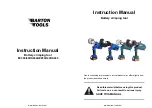
19
Check the Center of Gravity (C.G.)
NOTICE:
Same as the control throws, the C.G. has a
great effect on how every model fl ies, so do not skip this
procedure. If the model is tail-heavy it may be too unstable
and respond too quickly to the controls. If the model is nose-
heavy it may be too stable and not respond fast enough to
control input—in either case possibly causing a crash. Do
not overlook this important procedure.
64 mm
51mm
2-1/2"
2"
Standard
Metric
❑
1. Mark the
forward
and
aft
C.G. limits on both sides of
the bottom of the wing 2" and 2-1/2" [51mm and 64 mm]
back from the leading edge where shown—using narrow
strips of tape will allow you to feel the marks when lifting
the model with your fi ngertips to balance.
❑
2. Install the battery, battery hatch and cabin hatch.
At this point the model must be in ready-to-fl y condition
with everything attached and installed including the fl oats
or wheels and battery and propeller.
CAUTION:
When checking the C.G., the battery
should be installed, but remain DISCONNECTED.
❑
4. Lift the model by your fi ngers between the lines
indicating the balance range. As long as the model sits level
with your fi ngers on the
forward
or
aft
lines or anywhere
between
the lines it is properly balanced and ready to fl y.
If you have to move your fi ngertips outside the lines the
model is out of balance and should not be fl own. If necessary,
add squares of stick-on lead to the nose or tail to get the
model to balance within the specifi ed range.
FLYING
When powering up, make sure the throttle stick is in
the minimum (0%) position.
Always
turn the transmitter
ON
before
plugging the battery into the plane.
The Turbo Beaver model fl ies mostly the same as any similar-
type, high-wing airplane, but you may fi nd that the roll rate
is a little slower. This suits the Turbo Beaver well as it is a
scale-like, STOL (Short TakeOff and Landing) craft. Just give
yourself more time and altitude before trying your fi rst full roll.
The only peculiarity arises when the fl aps are extended—if
you extend the fl aps too soon before the model has lost
enough fl ying speed the nose will pitch up. The way to avoid
this is fi rst by making sure you have given the model enough
time to slow after cutting the throttle. You can also roll in
the fl aps gradually. If you have a computer radio you could
also mix in some down elevator with fl aps. In any regard,
once the model reaches “equilibrium” and has initiated a
gliding descent the nose will resume a normal, downward
glide angle. Similarly, when powering up the throttle with
the fl aps extended the nose will pitch up, so be ready to
counter with down elevator.
Unless weather conditions are poor, you should have no
trouble fl ying the Turbo Beaver plane from either rough or
calm water. The water rudders direct the model well and
they don’t have to be perfectly centered to be effective (so
don’t spend an exorbitant amount of time on the work bench






































